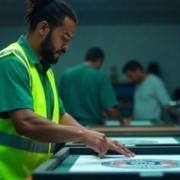Screen Printing Methods: Everything You Need to Know
Screen printing is one of the most popular and versatile printing techniques used worldwide. Whether for creating customized apparel, posters, or promotional items, this method delivers exceptional results. In this guide, we’ll explore the different types of screen printing processes, common screen printing presses, and essential techniques you should know.
What Is Screen Printing?
Screen printing is a printing technique where ink is pushed through a stencil (or screen) onto a surface. The stencil blocks out areas where ink shouldn’t pass through, leaving behind a clean and precise design. This method is widely used for textiles, ceramics, paper, and even glass.
Six Types of Screen Printing Processes
There are several ways to perform screen printing, each suited for specific materials and designs. Let’s break them down:
1. Spot Color Screen Printing
This is the most common method, using individual colors applied directly to the material. It’s ideal for bold and vibrant designs that don’t require blending or shading.
2. Halftone Printing
Halftone printing uses a single color but creates the illusion of gradients or multiple shades. This is achieved by varying the size and spacing of dots within the design.
3. Grayscale Printing
Grayscale printing is similar to halftone but focuses solely on black ink. It’s used for creating detailed images in grayscale, often on lighter backgrounds.
4. CMYK (Four-Color Process) Screen Printing
The CMYK method uses cyan, magenta, yellow, and black inks to create full-color images. This process is perfect for printing detailed, photorealistic designs on light-colored materials.
5. Simulated Process Screen Printing
Simulated process printing combines spot colors with halftones to mimic the look of full-color designs. It’s especially useful for dark garments or complex artwork.
6. Discharge Printing
This technique removes dye from dark-colored fabrics, leaving behind a lighter, softer design. It’s great for vintage-style prints with a soft feel.
Three Common Types of Screen Printing Presses
The printing press is a crucial tool in the screen printing process. Each press type offers unique advantages:
1. Manual Screen Printing Press
Manual presses require hand operation, making them cost-effective and straightforward to use. They’re best for small runs or beginner screen printers.
2. Automatic Screen Printing Press
Automatic presses use motorized systems to handle the printing process. They are perfect for large-scale production as they save time and improve consistency.
3. Semi-Automatic Screen Printing Press
Semi-automatic presses combine manual and automated features. They are a middle-ground option, offering efficiency without the high cost of fully automatic machines.
Essential Screen Printing Techniques
Screen printing isn’t just about choosing the right process and press; techniques play a key role in achieving excellent results. Here are a few to keep in mind:
Proper Screen Preparation
Ensure the screen is clean and properly coated with emulsion. This step determines the clarity and precision of your print.
Use of High-Quality Inks
The quality of your ink affects the durability and vibrancy of your design. Choose inks that suit your material and intended use.
Consistent Squeegee Pressure
The squeegee is used to push ink through the screen. Apply even pressure to avoid blotchy or uneven prints.
Curing the Ink
After printing, the ink must be cured or heat-set to ensure it adheres properly. This prevents cracking or fading over time.
Benefits of Screen Printing
Screen printing offers many benefits, which is why it remains a top choice for printing professionals:
- Vibrant Colors: Screen printing produces bold and vivid colors that last.
- Versatility: It works on a wide range of materials, from fabric to glass.
- Durability: The prints are long-lasting, even after multiple washes.
- Cost-Effective for Bulk Orders: Larger quantities reduce the cost per piece.
Challenges in Screen Printing
Like any technique, screen printing has its challenges. However, understanding them can help you overcome obstacles:
- Setup Time: Preparing the screen and stencil can be time-consuming.
- Not Ideal for Small Runs: The setup cost makes it less economical for small batches.
- Limited Color Mixing: Achieving certain colors may require additional layers or specialized processes.
Final Thought
Screen printing is a time-tested method for creating high-quality, durable designs. With six different processes, three types of presses, and countless techniques, there’s something for every project. Whether you’re printing a single T-shirt or thousands of promotional items, screen printing delivers unmatched results.
By understanding the basics and investing in the right tools, you can master this versatile printing method. Whether you’re a beginner or a professional, screen printing offers endless possibilities to bring your designs to life.





